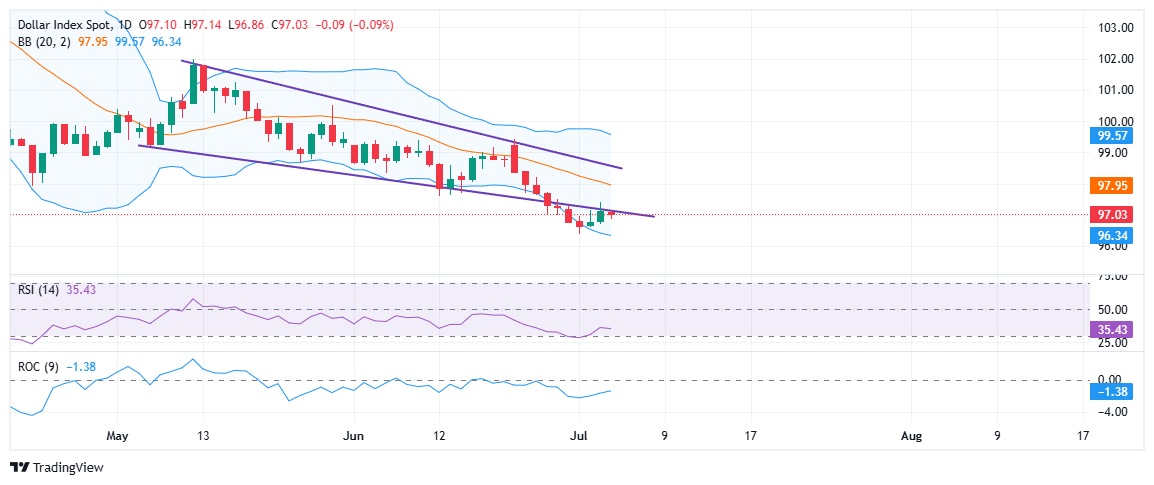US Dollar shows little movement amid muted market activity

- The US Dollar edges lower on Friday in thin holiday trade, snapping a two-day winning streak.
- Tariff tensions resurface as Trump prepares to send letters imposing unilateral trade duties from August 1.
- US President’s “One Big Beautiful Bill” passes the House of Representatives, raising long-term debt concerns.
The US Dollar (USD) eases on Friday, drifting lower in holiday-thinned trading and snapping a two-day winning streak. After climbing on the back of stronger-than-expected US (DXY) broke below a descending wedge pattern earlier this week. The index attempted to reclaim the 97.00 mark on Thursday following stronger-than-expected Nonfarm Payrolls data but failed to hold above it. The bounce stalled right at the broken wedge support, which has now turned into resistance. This failed retest reinforces the bearish setup, as DXY edges lower during Friday’s trading session, trading just below the 97.00 threshold.
The price is also sitting below the 20-day moving average, which also serves as the middle Bollinger Band, indicating that upside momentum remains weak. Unless bulls manage a clean breakout above this zone near 97.00–97.20, the broader bearish trend is likely to stay in place.
Momentum indicators also reflect a cautious tone. The Relative Strength Index (RSI) is hovering just above 34, staying in bearish territory but showing early signs of stabilization. Meanwhile, the Rate of Change (ROC) remains negative, indicating selling pressure is still present, though not accelerating.
If the DXY breaks below its immediate support near 96.30, the lower Bollinger Band, it could open the door to a fresh downside move targeting 95.00. On the other hand, a strong close above the wedge could spark a short-term recovery, but for now, the US Dollar remains under pressure.
Fed FAQs
Monetary policy in the US is shaped by the Federal Reserve (Fed). The Fed has two mandates: to achieve price stability and foster full employment. Its primary tool to achieve these goals is by adjusting interest rates.
When prices are rising too quickly and inflation is above the Fed’s 2% target, it raises interest rates, increasing borrowing costs throughout the economy. This results in a stronger US Dollar (USD) as it makes the US a more attractive place for international investors to park their money.
When inflation falls below 2% or the Unemployment Rate is too high, the Fed may lower interest rates to encourage borrowing, which weighs on the Greenback.
The Federal Reserve (Fed) holds eight policy meetings a year, where the Federal Open Market Committee (FOMC) assesses economic conditions and makes monetary policy decisions.
The FOMC is attended by twelve Fed officials – the seven members of the Board of Governors, the president of the Federal Reserve Bank of New York, and four of the remaining eleven regional Reserve Bank presidents, who serve one-year terms on a rotating basis.
In extreme situations, the Federal Reserve may resort to a policy named Quantitative Easing (QE). QE is the process by which the Fed substantially increases the flow of credit in a stuck financial system.
It is a non-standard policy measure used during crises or when inflation is extremely low. It was the Fed’s weapon of choice during the Great Financial Crisis in 2008. It involves the Fed printing more Dollars and using them to buy high grade bonds from financial institutions. QE usually weakens the US Dollar.
Quantitative tightening (QT) is the reverse process of QE, whereby the Federal Reserve stops buying bonds from financial institutions and does not reinvest the principal from the bonds it holds maturing, to purchase new bonds. It is usually positive for the value of the US Dollar.
